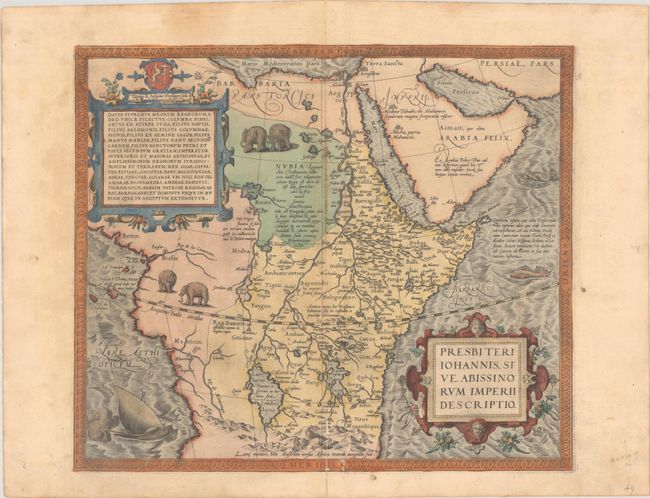Subject: Central Africa
Period: 1574 (published)
Publication: Theatrum Orbis Terrarum
Color: Hand Color
Size:
17.3 x 14.6 inches
43.9 x 37.1 cm
The mythical kingdom of Prester John is one of the most persistent legends of all time and often appears on early maps. This myth had its origins in rumors spread throughout Europe in about 1150 A.D. that there was a powerful Christian priest-king who had conquered the Muslims and founded the kingdom of Kara Khitai in Asia. This mysterious king became a symbol of hope in the Christian world, which at the time was beset by the Mongol hordes. A succession of Dominican and Franciscan missionaries and civil ambassadors were dispatched by popes and European monarchs to search for the kingdom. Many of these emissaries never returned, and those that did reported that the Christian kingdom in deepest Asia could not be found and was probably a myth. But the popular fancy was not easily dispelled, and so over time the location of the kingdom was merely transferred to Africa. Prester John's kingdom can be found on early maps in Scythia, India, Central Asia and Abyssinia.
This great map depicts the central African kingdom of Prester John, the mythical Christian priest-king who, according to legend, provided a bulwark against Barbarians and was an ally to the Crusaders. Ortelius designed this map himself using geographical information including Gastaldi's 1564 map of Africa. The mythical twin lakes of Zaire and Zaflan are shown as the origin of the Nile, with the Mountains of the Moon located as the source of the lakes. Two pairs of large elephants appear in the interior, and sea monsters and an Arabic ship (dhow) are depicted in the Atlantic. Two large strapwork cartouches balance the sheet, one enclosing the title and the other with text of the legend. The dedication is to King David, with a long genealogy tracing Prester John's lineage back to that of the Biblical king. Latin text on verso.
References: Norwich #11; Van den Broecke #175.
Condition: B+
Full contemporary color on a sheet with the crossed arrows watermark commonly found on Ortelius maps. There is some light toning and soiling, a bit of foxing along the centerfold, and two tiny wormholes only visible when held to light. A 3" centerfold separation at center and a 2" separation at bottom with associated minor abrasions have both been closed on verso with archival tape.


